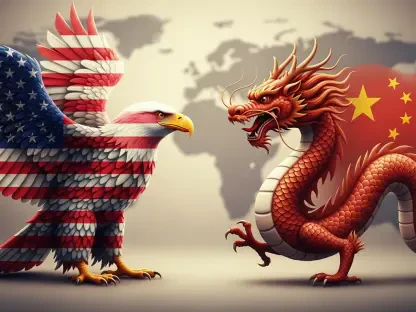Meet Donald Gainsborough, a political savant at the helm of Government Curated. With years of experience in policy and legislation, he’s well-equipped to provide deep insights into current affairs. In today’s conversation, we explore President Trump’s approach to governing military academies and the broader implications for public education.
What are your thoughts on President Trump’s approach to governing military academies?
President Trump’s approach to governing military academies is one of strict control and quick implementation of policies. He leverages the relatively unchallenged authority he has over these institutions to drive changes swiftly, such as banning DEI programs and regulating transgender athletes. This approach indicates a desire for uniformity in values that align with his administration’s broader educational reforms.
Do you think his policies at military academies reflect what he wants to see in public schools?
Absolutely. The policies at military academies serve as a microcosm of what Trump envisions for the nation’s public schools. The rapid execution of these changes at military schools likely reflects his ideal scenario for public institutions: less bureaucracy, more direct control, and a definite ideological slant.
How do you feel about the difference in control between military academies and public schools?
The difference in control is quite significant. Military academies are under direct federal oversight, allowing for quicker and more cohesive implementation of policies. Public schools, on the other hand, face layers of state and local governance, which can slow down or even halt policy changes. This disparity makes military academies a more straightforward arena for the administration to enact its vision.
Can you elaborate on how military academies are under a different set of laws compared to public institutions?
Military academies operate under a distinct legal framework compared to civilian educational institutions. They are governed directly by federal regulations and the Department of Defense, bypassing much of the red tape that public schools encounter. This specific legal context helps to streamline policy implementation but also limits avenues for legal recourse by students and faculty.
How does this legal difference impact the policies that can be implemented?
This difference allows for much swifter policy changes and enforcement at military academies. For instance, executive orders impacting DEI or gender identity issues can be applied almost immediately without the prolonged debates and legal challenges typical in public schools. While this can bring about rapid changes, it also means there is less opportunity for stakeholder input or opposition.
Bobby Jones mentioned that the military can be a “social experimentation area.” Can you explain what he means by that?
Jones is referring to the controlled and hierarchical environment of the military, which makes it an ideal setting for testing new social policies. In this controlled environment, compliance is mandatory, enabling the administration to observe the effects of these policies before potentially rolling them out to larger, more diverse civilian populations.
Do you agree with his assessment?
Yes, to some extent I do. The military’s structure inherently requires adherence to order, making it a relatively easier setting to implement and assess the outcomes of new policies. This can provide a clearer picture of potential impacts before considering broader application in more varied and less controlled environments like public schools.
How might this affect the future of both military and public education systems?
This experimentation could lead to significant shifts in both systems. If policies prove effective or face little resistance in military academies, there may be a push to introduce similar measures in public schools. However, this could also deepen ideological divides as policies from a more conservative framework encounter resistance in the more diverse setting of public education.
How have the executive orders signed by President Trump impacted military academies so far?
These orders have led to swift and significant changes. For example, the removal of DEI-focused books from the US Naval Academy and the cessation of race-conscious admissions policies at both the Naval and Air Force Academies show a decisive move towards reshaping the environment in line with the administration’s ideologies.
Can you provide specific examples of changes that have been made?
Yes, apart from the book removals and admissions policy changes, there have been regulations ensuring that sports teams are categorized by biological sex rather than gender identity. These changes are indicative of a larger agenda to recalibrate the social and moral culture within these institutions.
How quickly have these changes been executed compared to other education orders?
The changes within military academies have been executed markedly quicker. This is due to the top-down control and the specific legal framework that allows the executive branch to bypass many of the local or state-level bureaucratic hurdles that public schools face.
The U.S. Naval Academy removed about 400 books from its library. What were the reasons given for these removals?
The official reason given was to ensure compliance with the directives outlined in President Trump’s executive orders, particularly those targeting DEI initiatives. The Academy stated that the removal was necessary to align with the new policies mandated by the administration.
How has the academy justified its compliance with the executive orders?
The academy has justified its compliance by highlighting its obligation to adhere to the directives from the administration. In essence, as a federal institution, it must operate within the bounds of federal executive orders, which currently dictate the removal of DEI-related materials.
Are other military academies expected to follow suit?
Yes, it is highly likely that other military academies will follow suit as they review their own curriculums and libraries to ensure they are aligned with the new directives. Institutions like West Point and the Air Force Academy are already in the process of assessing their compliance.
What developments have occurred regarding affirmative action policies at the Naval Academy and the Air Force Academy?
Both academies have ceased considering race and ethnicity in their admissions processes. This development is significant as it aligns with recent executive orders aimed at curtailing affirmative action in favor of more race-neutral admissions policies.
Jonathan Butcher from the Heritage Foundation mentioned that Trump’s orders could be “doubling down on how we understand civil rights law.” Can you explain this perspective?
This perspective suggests that Trump’s orders are reinforcing a more traditional interpretation of civil rights laws, focusing on equality without consideration of diversity measures. It implies a shift towards policies that emphasize uniform treatment of individuals regardless of race, potentially at the expense of efforts aimed at promoting diversity.
How do you think this impacts the overall direction of civil rights in education?
This approach could lead to a retraction of civil rights policies that have historically aimed to correct systemic inequalities. It may result in a more homogenized educational environment that disregards the nuanced needs of marginalized groups, potentially exacerbating existing disparities.
How have schools under the Department of Defense Education Activity (DoDEA) been affected by these policies?
DoDEA schools have seen similar swift changes, especially concerning DEI initiatives. Books and lesson plans promoting diversity have been removed, and new guidelines have been implemented to ensure that programs and facilities for girls are only accessed by those assigned female at birth.
What specific changes have been made regarding books, lesson plans, and facilities for girls?
Books that promote DEI have been pulled from classrooms, lesson plans with a focus on diversity have been scrapped, and facilities for girls now strictly adhere to the biological definitions of sex. These changes are part of a broader effort to align with the administration’s policies.
There have been student protests at DoDEA schools. What events triggered these protests?
The main triggers were the removal of DEI programs and book bans. These changes sparked significant unrest among students who felt that their learning environment and access to diverse perspectives were being compromised.
What has been the response from the DoDEA to these protests?
The DoDEA has reiterated its commitment to its policies on attendance and student discipline, indicating that such protests disrupt normal operations. However, it also emphasized its encouragement of civic engagement through more formal channels like student government, rather than walkouts.
For those at military academies and DoDEA schools, what mechanisms are available to challenge policy changes?
Students and faculty in these institutions have limited recourse. Unlike public schools, military academies and DoDEA are subject to stricter federal oversight, and most policy changes come from the top. Thus, avenues for challenging these changes are far more constrained.
How do these mechanisms compare to those available in public schools?
Public schools usually have more robust systems for contesting policy changes, including community boards, local government, and court challenges. Military academies and DoDEA schools are more directly controlled by federal authorities, limiting the options for dispute.
How has President Trump influenced the composition of the boards that oversee service academies?
Trump has significantly altered the composition of these boards by appointing individuals who are closely aligned with his policies and ideologies. This includes conservative activists and former administration officials who support his agenda.
Can you describe the types of individuals he has appointed to these boards?
Trump has appointed conservative figures like Charlie Kirk, Senator Tommy Tuberville, retired Col. Doug Nikolai, and Dina Powell, each known for their strong alignment with his administration’s values and policies. This ensures that his agenda is reinforced at the governance level of these academies.
What long-term impact do you think these policies and appointments might have on military academies and public schools?
The long-term impact could be substantial. By solidifying control over military academies and attempting to extend similar policies to public schools, the administration might create lasting changes in how educational institutions operate. If these initiatives continue, they could influence the educational and social experiences of future generations, potentially leading to more ideologically uniform environments.
Do you have any advice for our readers?
Stay informed and engaged. The policies and changes discussed here are broad and impactful. Understanding their implications can help communities better navigate and respond to shifts in educational policy. Whether you’re a student, educator, or concerned citizen, your voice and actions matter in shaping the future of education.









